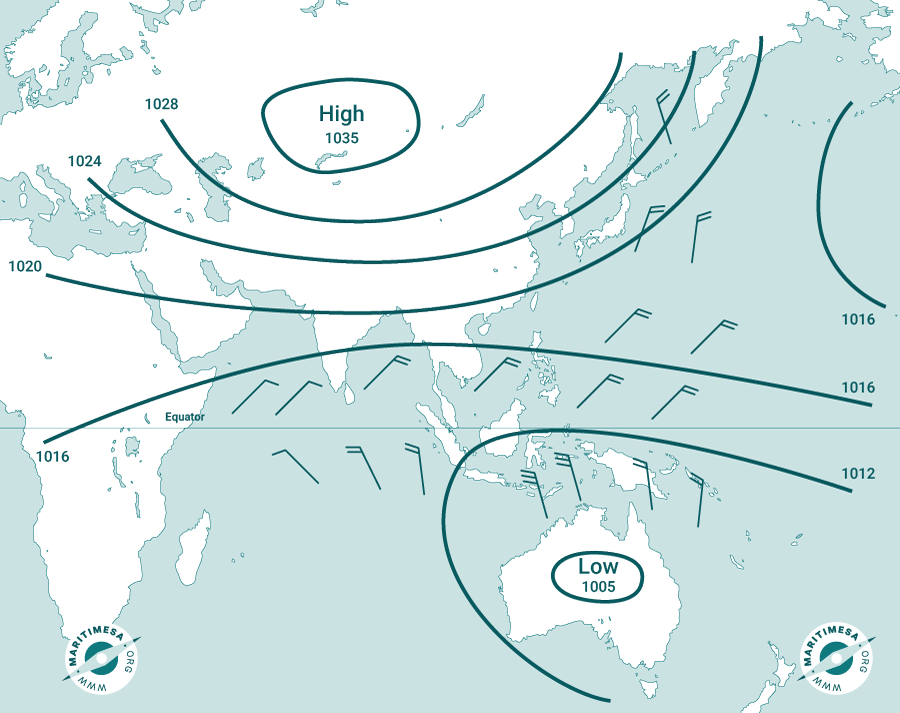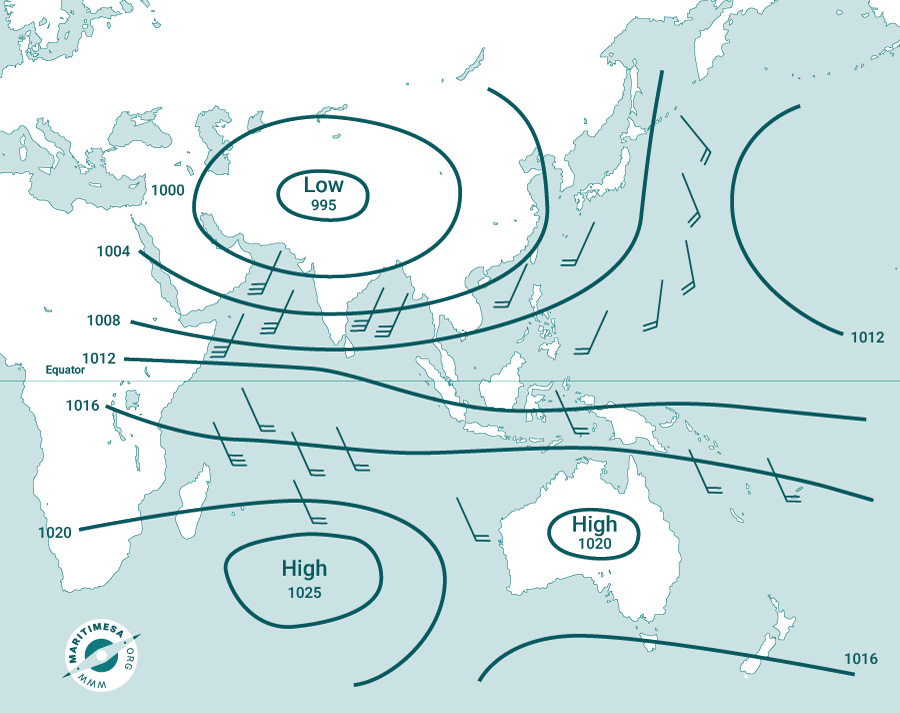The oceanic winds experienced in the various climate zones are described in the following sub paragraphs:
- Doldrums. The doldrums is that part of the ocean situated in the equatorial trough of low pressure between the trade winds of the two hemispheres. This weather in this zone is characterised by calms, light variable winds alternating with squalls, heavy rain and thunderstorms. Except for the short-lived squalls and tropical storms, we do not find gales in this area.
- Trade winds. The weather in this zone, which lies to the north and south of the Doldrums, is characterised by the north-east and south-east trade winds which blow steadily throughout the year. They vary little in their direction and their average strength is around force 3 to 4 on the Beaufort scale. At times they may increase to force 5 or 6 and at others they could drop to force 1. Except for the occasional squall, winds of gale force are very rare and when they do occur it is usually with tropical storms. There are, however, areas where the trade winds do not blow, namely in the northern part of the Indian Ocean and the western part of the north Pacific Ocean. These areas experience what is referred to as the monsoons. An explanation for these will be given shortly.
- Variables. In each hemisphere there is an area which experiences mainly light to moderate winds. These areas lie between the pole-ward limits of the trade wind zones and the zones referred to as the “Westerlies”. These areas/zones are referred to as the Horse latitudes and the winds experienced here are called the Variables. The areas are centred on latitude 30° north and south. South Africa lies within this zone. Towards the equator these winds gradually merge with the trades. Towards the poles they merge with the westerlies.
- Westerlies. Pole-wards of the Variables in each respective hemisphere lies an area which experiences mainly westerly winds. Although they are mainly westerly in direction, they are not permanent as is the case with the trades. The reason for this is the constant passage of depressions through the zone which causes much variation in direction and strength of the wind. Gales are common especially south of 40° south which has earned the name of Roaring Forties for the area.
- Monsoons. These winds are seasonal of nature and are caused by the summer heating and winter cooling of the Asian land mass/continent.
- North-east Monsoon of the China Sea and Indian Ocean. During the northern winter, the Asian continent is cooled and an intense high pressure system develops over eastern Siberia. The winds circulating around this area of high pressure form the north-east monsoon. In the northern part of the China Sea the gradient is large and the winds are likely to be north-westerly force 6 to 7. Further south where the pressure gradient is smaller, the wind will be northerly, force 5 to 6. In the Bay of Bengal and the Arabian Sea winds are north-easterly force 3 to 4. Any rainfall on the windward coasts will most likely be light/ scattered showers. Because of the polar origin of the wind, the relative humidity will be low. The North-east Monsoon occurs early in December and continues until April.

North-east Monsoon (northern hemisphere winter).
- North-west Monsoon of Australia. During the summer in the southern hemisphere a low pressure forms over the deserts of Australia. The pressure gradient from the high over Siberia is continued to the abovementioned low. The north-east Monsoon winds blow down to and past the equator. On passing the equator these winds are deflected to the left, giving north-west winds on the coast of Australia. Having blown over thousands of miles of ocean, the air has a high relative humidity and periods of rain can be expected. The wind is unlikely to exceed force 6 to 7 and is frequently less. The duration of this monsoon is similar to that of the north-east monsoon.
- South-West monsoon of the Indian Ocean and the China Sea. During the northern summer, the Asian continent is warmed, the high pressure area over Siberia decreases and is replaced by a low pressure over north-west India. There is a pressure gradient between the high pressure over the south Indian Ocean and the lows over Africa and India. This causes the south-east trade to blow up to the equator and on crossing it, the wind near the African coast circulates around the low over Africa and brings rainfall to East Africa. Away from the coast the wind is deflected to the right and blows from a south westerly direction. In the Arabian Sea the wind is south-west, force 7 to 8. In the Bay of Bengal winds from the south-west of force 6 to 7 can be expected. In the southern part of the China Sea the wind is southerly, force 4 to 5. The northern part of the China Sea has light south-easterly winds. The air forming the south-west Monsoon has travelled over thousands of miles of ocean and is saturated. This results in heavy rain, especially near the coasts and poor visibility. The south-west Monsoon lasts from June to October.

South-west Monsoon (Northern hemisphere summer).
- North-east Monsoon of the China Sea and Indian Ocean. During the northern winter, the Asian continent is cooled and an intense high pressure system develops over eastern Siberia. The winds circulating around this area of high pressure form the north-east monsoon. In the northern part of the China Sea the gradient is large and the winds are likely to be north-westerly force 6 to 7. Further south where the pressure gradient is smaller, the wind will be northerly, force 5 to 6. In the Bay of Bengal and the Arabian Sea winds are north-easterly force 3 to 4. Any rainfall on the windward coasts will most likely be light/ scattered showers. Because of the polar origin of the wind, the relative humidity will be low. The North-east Monsoon occurs early in December and continues until April.

